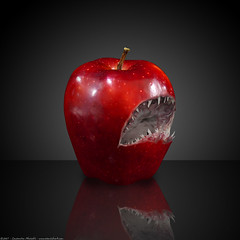The Scariest Part of Digital Photography
Digital photography has been a revolution. The clumsy stage of major innovations, breakthroughs, and failures seems to be a thing of the past. Cameras are reliable, fast, friendly, and affordable. Digital storage is cheap and expandable. Software is usable and powerful. Everything is just perfect, right?
Wrong. Nothing is free in this world. With each step forward, we pay a price. Sure, digital cameras are great… but what about the headaches they cause? The more photos we capture and store, the harder it is to keep track of them and keep them safe. Many new photographers don't realize this, but a year or two down the road they're going to find themselves in a sticky situation due to poor data management techniques.
I can hardly imagine that many people have a foolproof plan laid out for photo management the instant they buy their first camera. The need doesn't become apparent (or necessary) until you reach a certain critical mass of files. And the brutal realization for this need usually crops up shortly after you decide that you want to make money from your photos. But that's the catch, you never can tell if that's where you're heading until it's too late.
Experienced photographers will tell you that photo management is very important… yes, we've all heard it. Again, this advice doesn't become obvious until it's too late. It's easy to find reasons for skimping on the data management, but it's hard to find time to fix our mistakes. I often wish I could send my past self a piece of advice:
When it comes to data management, do it right the first time… and do it religiously. Do your research and take the advice from the experts — they know what they're talking about. Spend a few extra minutes managing your photos NOW, and save yourself hours LATER.
While I'm in no place to call myself an expert at this point in my photography career, I feel that I can offer some bits of expert advice on certain topics within data management. Neil's series on Image Organization really helped to drive home a lot of things that I knew I should be doing. From that point forward, I've been developing and refining my good habits and practices.
I'd like to expand on Neil's articles, but with a heavy emphasis on my most important tool for file management. I now use Adobe Bridge to manage my photos and I can't believe I haven't been doing this for the last several years. In the course of the next few weeks, I'll cover topics directly related to using and utilizing Adobe Bridge — sort of a user guide, tips, tricks, and reference.
By the looks of our current poll on Photo Editing Software, nearly 40% of us use Photoshop/ACR. For those folks, Bridge is at your fingertips. We also have over 25% Lightroom users — and (from what I've seen) it looks like Lightroom shares many common features with Bridge and Camera Raw.
So I'll lead some discussions on targeted topics and functionalities within the software, and I'll rely on you more experienced folks to fill in the cracks and expand upon what I present. For those of you with access to this software, listen closely as the discussions go on and don't take the advice lightly. And for the folks who don't use or plan on using these pieces of software, listen up anyways — you may need it someday.
I'm looking forward to it, but is anybody else interested?


Bet
March 14, 2008Definitely interested in tips, tricks and any advice when it comes to software. There are always little tidbits that I might not catch myself that someone else will. That’s the great thing about blogs like yours.
Cyler
March 14, 2008I clicked Lightroom in the poll, but I also use PS when a photo calls for more than just the RAW conversion. I used to use Bridge on my old computer because it was too slow for Lightroom. Adobe Lightroom is ACR/Bridge on steroids.
Gowri
March 14, 2008Hi Brian,
I can’t thank you enough for posting this article….not even a year down since I started photography I am already beginning to realise the importance of data management. The huge amount of files that can pile up in your computer is just unimaginable! And every time I sort my pictures I feel the need to sort them in a different way, within two weeks and it takes an awful lot of time too…..so am looking forward to more posts on the topic! Thanks so much!
Cheers,
Gowri.
Jim Goldstein
March 14, 2008I look forward to your articles to come on the topic. Although I’m not using Bridge for this purpose I’ll be interested to see what is common between your approach with Bridge and my efforts with Lightroom.
BTW nice ProBlogger hook 😉
Regards
Jim
Antoine Khater
March 14, 2008I never found any piece of software that can fill my photo management needs.
I have, as of today, a bit more than 55k pictures that I keep track using my “own workflow” no specific software just some common sense and personal logic.
Result I can find any picture of mine in less than 1 min, honestly I am pretty happy with it although it may not fit anyone else’s needs.
bob colameco
March 14, 2008Yes! Yes! I am very interested in this topic. I purchased my camera close to a year ago and I am struggling with this. I look forward to reading your ideas.
libeco
March 14, 2008I know I have to change my management by at least adding keywords or even descriptions to foldernames instead of dates only, but so far I haven’t really done so. I hope you can give some good ways of managing pictures before it’s too late for me… 🙂
GW
March 14, 2008/offtopic
lightroom 1.4 is out , and it looks like they fixed the greyscale conversion noise problem.
go and get it!
Brian Auer
March 14, 2008Wow gang! It looks like there’s some interest in the topic. That’s a good thing! We’ll kick off Monday with an introduction to Bridge and I’ll touch on some of the topics I plan on covering. If you guys have something specific in mind that you want to know about Bridge, let me know and I’ll be sure to include it in the series.
When all is said and done, maybe we can find some expert Lightroom users to hit the same topics in that software since it seems to be getting ever more popular.
AlaskaTeacher
March 14, 2008Definitely interested!!! My brother-in-law has been trying to convert me to Lightroom for quite a while… I haven’t thought seriously about it yet because I don’t have so many images that organization is a problem…yet… I want to avoid future disasters. Teach me! 🙂
Deborah
March 14, 2008I’m excited to hear about the upcoming Bridge articles. Look forward to reading the articles on Bridge, and hopefully in the future, articles on Lightroom.
Luis Cruz
March 14, 2008I’m definitely interested. I’ve got several thousand images in my archives and I don’t know when I’ll get around to to tagging, rating, flagging, and basically organizing all of them. Having Lightroom helps, but it’s still a daunting task. Still, now is as good a time as ever, right?
bob colameco
March 15, 2008I have tried on several occasions, but I still cannot figure out how to add a keyword to my pictures in bridge. Perhaps you can address that at some point. Thanks!
Brian Auer
March 16, 2008Keywording will definitely be on the agenda. It’s actually quite easy with Bridge, and there are several methods of doing that. I’ll try to touch on each of them.
Derek
March 18, 2008I know I’m late to the game with this comment, but literally the bible for this stuff is Peter Krogh’s “The DAM Book.” (DAM being digital asset management) He not only covers the major software pieces of the puzzle, but how things like backup strategy, storage device size and lots more play into the equation.
Amy
March 18, 2008Very behind in my feed reader but did my own photo management list only yesterday. Interested to see what you come up with and suggest.
Would love you to pop over and add any feedback to mine if you have time.
I dont use Bridge, or any of the other ones you mentioned. I use a program called Memory Manager, Whose sole purpose in life is to help album makers organise photos for albums. 🙂